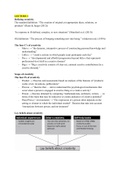LECTURE 1
Defining creativity
The standard definition: “The creation of original yet appropriate ideas, solutions, or
products” (Runo & Jaeger (2012))
“In response to ill-defined, complex, or new situations” (Mumford et al. (2013))
Old definition: “The process of bringing something new into being.” (Anderson (ed.) (1959))
The four C’s of creativity
- Mini-c → “the dynamic, interpretive process of constructing personal knowledge and
understanding”
- Little-c → “creative actions in which people (can) participate each day”
- Pro-c → “developmental and effortful progression beyond little-c that represents
professional-level skill in a creative domain”
- Big-c → “Big-c creativity consists of clear-cut, eminent creative contributions [to a
creative domain].”
Scope of creativity
The four Ps of creativity
- Product → Theories and assessments based on analysis of the features of “products:
works of art, inventions, publications”
- Process → “theories that … aim to understand the psychological mechanisms that
occur when a person is engaged in creative thing or a creative activity”
- Person → theories obtained by comparing “mathematicians, architects, writers, … in
terms of the traits that may be indicative or contra-indicative of creative potential”
- Place/Press (= environment) → “The expression of a person often depends on the
setting or climate in which the individual resided". Theories that take into account
“interactions between person, and environment”
Lay beliefs about creativity
,Lay beliefs (I)
- on process. Creativity comes
- unexpectedly
- when defocused (vs. focused)
- On place. Creativity happens when
- Traveling (vs. at work)
- Relaxing (vs. under time pressure)
- On groups. Creativity happens when
- Working alone (vs. together)
- With creative others
Lay beliefs (II)
- On process. Creativity requires
- Flexible processing
- Approach orientation
- On mood states. Creativity benefits from
- Positive moods
- Deactivating moods
LECTURE 2 - Models of creativity
Early models of creativity
Wallas (1926) stage model
“Preliminary analysis of a problem, defining and setting up
the problem. Conscious work that draws on education,
analytical skills”
“ no conscious work on the problem”
“Occurs when the promising idea break through to conscious
awareness”
“involves evaluating, refining, and developing one’s idea”
Guildford’s (1957) divergent/convergent thinking
,Divergent thinking → Problem, one idea, basis, generate all kinds of variations/ideas. Create
possibilities. Problem → idea.
Convergent thinking → A lot of ideas/materials, try to work towards a final outcome. Idea →
solution.
Campbell’s BVSR model (1960)
Two stages (iterative)
1. Blind variations
2. Selective retentions
Geneplore model (1992)
You generate a bunch of ideas, but are not
the invention yet, and you then evaluate and
explore these ideas. Prototyping. It all
happens on the product constraints, e.g., user
needs, amount of money.
Stage models of creativity
, Cognitive models (Mumford & McIntosh (2017))
Facilitations models (Isaksen, Dorval, & Treffinger (2010))
Applied models
Distributed models




